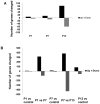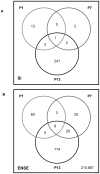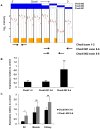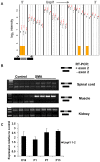Alternative splicing events are a late feature of pathology in a mouse model of spinal muscular atrophy
- PMID: 20019802
- PMCID: PMC2787017
- DOI: 10.1371/journal.pgen.1000773
Alternative splicing events are a late feature of pathology in a mouse model of spinal muscular atrophy
Abstract
Spinal muscular atrophy is a severe motor neuron disease caused by inactivating mutations in the SMN1 gene leading to reduced levels of full-length functional SMN protein. SMN is a critical mediator of spliceosomal protein assembly, and complete loss or drastic reduction in protein leads to loss of cell viability. However, the reason for selective motor neuron degeneration when SMN is reduced to levels which are tolerated by all other cell types is not currently understood. Widespread splicing abnormalities have recently been reported at end-stage in a mouse model of SMA, leading to the proposition that disruption of efficient splicing is the primary mechanism of motor neuron death. However, it remains unclear whether splicing abnormalities are present during early stages of the disease, which would be a requirement for a direct role in disease pathogenesis. We performed exon-array analysis of RNA from SMN deficient mouse spinal cord at 3 time points, pre-symptomatic (P1), early symptomatic (P7), and late-symptomatic (P13). Compared to littermate control mice, SMA mice showed a time-dependent increase in the number of exons showing differential expression, with minimal differences between genotypes at P1 and P7, but substantial variation in late-symptomatic (P13) mice. Gene ontology analysis revealed differences in pathways associated with neuronal development as well as cellular injury. Validation of selected targets by RT-PCR confirmed the array findings and was in keeping with a shift between physiologically occurring mRNA isoforms. We conclude that the majority of splicing changes occur late in SMA and may represent a secondary effect of cell injury, though we cannot rule out significant early changes in a small number of transcripts crucial to motor neuron survival.
Conflict of interest statement
The authors have declared that no competing interests exist.
Figures






References
-
- Wirth B. An update of the mutation spectrum of the survival motor neuron gene (SMN1) in autosomal recessive spinal muscular atrophy (SMA). Hum Mutat. 2000;15:228–237. - PubMed
-
- Lefebvre S, Burglen L, Reboullet S, Clermont O, Burlet P, et al. Identification and characterization of a spinal muscular atrophy-determining gene. Cell. 1995;80:155–165. - PubMed
-
- Lefebvre S, Burlet P, Liu Q, Bertrandy S, Clermont O, et al. Correlation between severity and SMN protein level in spinal muscular atrophy. Nat Genet. 1997;16:265–269. - PubMed
-
- Monani UR, Lorson CL, Parsons DW, Prior TW, Androphy EJ, et al. A single nucleotide difference that alters splicing patterns distinguishes the SMA gene SMN1 from the copy gene SMN2. Hum Mol Genet. 1999;8:1177–1183. - PubMed
Publication types
MeSH terms
Substances
Grants and funding
LinkOut - more resources
Full Text Sources
Other Literature Sources
Medical
Molecular Biology Databases

